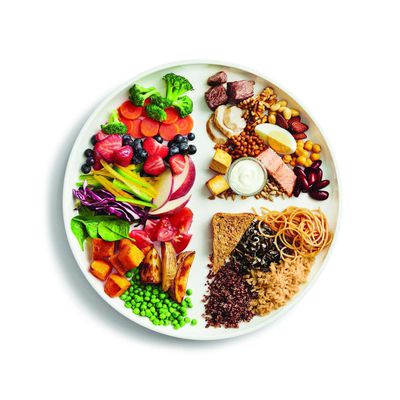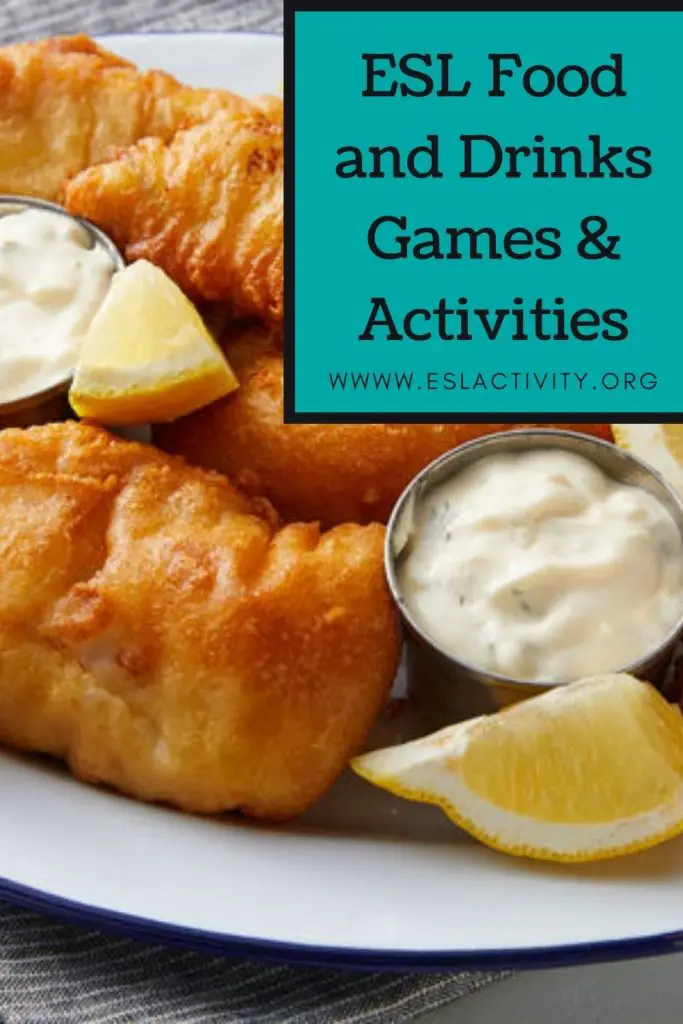The food unit is a classic in most ESL textbooks, especially for beginners and intermediates. However, it can get a little bit boring for the students, and the teacher as well, so mix things up with some of these ESL food games. They are perfect for ESL food lessons for kids as well as adults.
ESL Food and Drink Activities

ESL Food Activities and Games
Let’s get into the best ESL food and drink games and activities to try out with your students that are ideal for an ESL food lesson plan.
#1: Easy Food Vocabulary Quiz
Have some fun with this quick warm-up or review activity.
#2: Odd One Out
This quick warmer or ESL review game is ideal for beginner students who may be learning simple vocabulary like different fruits and vegetables.
The way it works is that you write 4 words in a group. For example:
Apple, Orange, Carrot, Banana
Then, students have to choose the odd one out and say why. This one would be carrot because it’s not a fruit.
Check out one of the best ESL Food games right here: Odd One Out ESL Warm-Up.
#3 ESL Food Activities: The Mystery Box Game
A fun way to introduce some food things with little kids is to do the mystery box game. Choose your objects carefully. They should be hard, and not prone to breaking or squishing. Some of the best things to include are:
- Apples
- Pasta
- Rice
- Harder vegetables like carrots, celery, etc.
Then, put them all inside a box and the students have to reach their hand in to see what they can feel. Once they do that, they have to guess what each object is. Find out all the details here:
- Amazon Kindle Edition
- Bolen, Jackie (Author)
- English (Publication Language)
- 187 Pages - 03/09/2016 (Publication Date)
#4 ESL Food Games: Dictogloss
This is a classic 4-skills ESL activity that’s ideal for just about any topic, including food. The way it works is that you find a short reading in your ESL book, or online, or make one yourself.
Then, you read it out quickly and the students have to work together to re-create the story, either through writing or speaking. You read it again and the students work to improve what they have until it’s close to the original.
If you want, you can make it a bit of a competition to see which team comes the closest. Learn more here:
#5: Food Videos
There are a ton of videos on both YouTube and English Central related to food. They make a nice warm-up or lead-in to the food unit. Or, you can use it a round-up at the end of class. Consider using them for your units on Christmas or Easter as well, which of course are ALL about the food.
Either way, don’t forget to use some activities related to the video to get the most value out of it. Check it out for yourself here:
#6: ESL Food Surveys
Just ask my students and they’ll tell you that surveys are one of my go-to ESL activities. I like to use them at least once a month in my classes. The best part? This versatile activity lends itself well to many topics, including food.
It takes just a few minutes to design a survey related to food and then your students will have an awesome activity to participate in. Plus, it’s one of the best WH questions activities. Learn more about it here:
#7: Food Idiom Activity
There are a ton of food idioms in English. Like literally hundreds, if not thousands of them. They can be a fun way to introduce some cultural things to your students that you might not otherwise have a chance to.
You can have some fun with idioms too. Check out this activity for doing just that: ESL Idiom Activity.
#8 ESL Food Activity: Menu Scanning
When we read something like a travel brochure, bus timetable or restaurant menu, we scan the menu for what we’re looking for, instead of reading word for word. This saves a ton of time and we can often find exactly what we’re looking for in seconds.
Help your students with this important reading skill in English by using restaurant menus. Check out this activity here. It’s for travel brochures, but you can easily adapt it to a menu:
Brochure Scanning ESL Reading Activity.
#9: The ESL Food Unit, for Korean Students
I lived in South Korea for 10 years and one of the things that I loved best about that country was the food. So, so delicious and even though I live in Canada now, I still regularly eat Korean food.
The problem with food units in textbooks and Korean students is the standard appetizer, main course, dessert thing just doesn’t really work because Koreans don’t really eat that. Or, meat, potato and vegetable.
That’s why there’s a better way. Find out what I did in my classes to adapt the food unit to their unique culture: Korean Students and the Food Unit.
#10: ESL Thanksgiving Activities
Thanksgiving is ALL about food and family, right? When this holiday comes around, I like to do a class about it and share some American and Canadian culture with my students. Here are some recommendations for the activities and games to consider:
ESL Thanksgiving Games and Activities.
For more ideas related to culture, have a look here:
Discussion Questions about Culture.
- Amazon Kindle Edition
- Bolen, Jackie (Author)
- English (Publication Language)
- 211 Pages - 07/12/2020 (Publication Date)
Also be sure to check this out: Language and Culture.
#11 Food Activity: Word Association
Do your students already know lots of vocabulary related to food? Then considering using this quick warm-up to help activate prior knowledge. The way it works is that students shout out some of the food words they know and think about how they relate to each other.
For example, you may have a branch for fruit, veggies, grains, dairy, restaurant things, cooking at home, etc. Learn more here: Word Association for ESL Students.
#12 ESL Food Activity: Just a Minute
If you’re looking for a warm-up related to food for more advanced level students, then consider Just a Minute. It’s easy to adapt it to food related topics.
#13: Flyswatter ESL Food Game
This is a really fun ESL game that you can use for just about any topic and it lends itself especially well to food. The way it works is that you write a bunch of words on the board and then you give hints to 2 students with flyswatters. The one to hit the correct words gets the point for their team.
Learn more about it here: Flyswatter ESL Food Game.
#14: Concentration ESL Memory Game
This is another fun ESL game for beginners that can easily be related to food. Make flashcards, half with pictures and then the other half with the corresponding word. The students mix them up, and place them face down.
Then, the first student chooses two cards. For example, a picture of a carrot, and the word apple. Not a match so they put them back down. And so the game continues.
You can find out all the details here: Concentration Memory Game.

Top 13 ESL Food Activities
#15 ESL Food Lesson: Use Yes/No Questions
If you teach beginners, one of the first grammar points you’ll typically find in most ESL/EFL lesson is the “be” verb. It’s relatively straightforward, but can get a little bit tricky with questions.
You’ll often find that food is one of the first topics students learn as well as it’s extremely concrete and can be easily conveyed using pictures. So, combine these yes or no activities with food and you’ll certainly have a winning lesson plan!
More details here: Yes and No Question ESL Activities.
#16: Typhoon Game
A nice way to review just about anything, including food and cooking vocabulary is with the typhoon game. Have a look here:
#17: Present Perfect Food Questions
For more advanced learners, the food unit is often combined with the present perfect. After all, food lends itself extremely well to these types of questions. For example,
- Have you ever tried any unusual food?
- What’s the best thing you’ve ever tried?
- Where’s the best restaurant you’ve ever eaten at?
There are a ton of activities you can use when teaching the present perfect to your students. You can learn more about it right here: Present Perfect ESL Games and Activities.
#18: Jigsaw Activities for Food
#19 ESL Food Activities: What are you Cooking?
Put students into groups of three and tell them to write down items from each of the following categories:
- 1 Meat
- 1 Dairy product
- 3 vegetables
- 1 Grain
- 1 Green vegetable
- 3 fruits
- 1 tin of some kind of food
- 1 jar of some food
- Something salty
- Something sweet
- 3 herbs or spices
Then, collect the papers from the students and redistribute them to the other groups. Then, each group has 10-15 minutes to make a three course meal with their ingredients, along with cooking oil, salt and pepper. However, they are not required to use all the ingredients if they don’t want to. It should consist of an appetizer, main course, and dessert.
When each group is finished, give them some time to prepare for their presentation. Each group will present their menu to the class. I usually require that each student in the group talks about one course.
Students can vote on their favourite menu that’s not their own! You can prepare a small prize for the winning team.
Procedure for this ESL Food Activity:
1. Put students into groups of three. They have to write down the required ingredients in each category.
2. Collect the papers and redistribute them to another team.
3. Each team must make a three course menu with their ingredients (appetizer, main course and dessert). They don’t have to use all the ingredients.
4. The teams do a short presentation about their menu, and the class votes on their favourite.
- Amazon Kindle Edition
- Bolen, Jackie (Author)
- English (Publication Language)
- 116 Pages - 02/02/2020 (Publication Date)
#20: ESL Quantifier Activities
Food and quantifiers like many/much/some/any are a natural fit which is why they’re often taught together in ESL textbooks. If this is the case for you and you want to spice things up a bit, check out these fun things you can do with your students.
Quantifier Activities for ESL.
#21: Games Involving Food and Drink
If you’re looking for a fun game that involves food, then you’ll want to try this “toilet paper” icebreaker. However, instead of using TP, you’ll want to use some small candies. I generally prefer wrapped candies for sanitary reasons, but you could also use something like Skittles or M & M’s.
The way it works is that students take a certain number of candies within a range. Then, for each candy they took, they have to say a fact about themselves, or they can also ask a follow-up question to another student. With each question or fact, they get to eat the candy!
Do you want to find out more details about one of the best games with food? Check it out for yourself right here: ESL Icebreaker Activity.

ESL food and drinks games
#22: Reading Lesson Plan About Food
In ESL textbooks, a common way that new vocabulary, including food is introduced is through a reading passage. However, instead of just quickly breezing through it, it’s possible to plan an entire lesson around it. Want to find out how? It can be a nice change of pace from most English classes which are heavy on the speaking and conversation.
ESL Reading Lesson Plan Template.
#23: Fruit and Vegetables Quiz
Try out this simple quiz for fruits and veggies:
#24: Ball Toss ESL Food and Drink Game
In this game, students toss a beach ball around the classroom and take turns speaking in English. In this case, you’d want to write a bunch of questions related to food on the ball such as the following:
- What’s your favourite food?
- Is there a food that you hate?
- Do you like to snack at night?
- What do you think about vegetables?
Find out more here about one of the best ESL food games:
Ball Toss ESL Speaking Activity.
#25: Vocab Auction
#26: Food Role Plays for ESL Students
A nice way to get beginners practicing using food and drink vocabulary is to do some role-plays. Students can take turns ordering food at a restaurant or coffee shop. Check out some of my favourite ideas:
#27: Drinks Vocabulary
Check out these fun ideas for teaching students the names of common beverages:
#28: Speaking Fluency Activity
To use this activity with the food unit, have students talk about their favourite food or restaurant.
#29: Me Too!
This is a simple listening and speaking activity for beginners. Students can take turns saying a food that they like or don’t like. If another student has the same like or dislike, they can stand up and say, “Me too!” Find out more here:
#30: Would You Rather Questions
There are a million and one would-you-rather questions related to food and drink. Check out this resource for some ideas:
- Amazon Kindle Edition
- Bolen, Jackie (Author)
- English (Publication Language)
- 81 Pages - 12/19/2022 (Publication Date)
#31: List of Vegetables in English
Check out these images and a helpful summary chart if your students want to learn some new vocabulary:
List of Vegetables in English (with pictures).
#32: Food Advertisements and Packaging
Analyze food advertisements and packaging materials with your students. Discuss persuasive techniques, food labeling, and nutritional information. Students can create their own advertisements or design food packaging using English slogans and product descriptions.
#33: Vegetables in English
#34: Food-Related Songs and Rhymes
Introduce catchy songs or rhymes related to food. Focus on lyrics that include food vocabulary, healthy eating, or table manners. Sing or recite the songs together, encouraging students to participate and practice pronunciation.
#35: Reading Food-Related Texts
Use food-themed reading materials such as recipes, restaurant reviews, food blogs, or articles about nutrition. Assign reading tasks and comprehension questions to improve reading skills, expand vocabulary, and stimulate discussion.
#36: Fruit Guessing Game
How well do your students know their fruits? Find out here with this fun quiz!
#37: Cultural Potluck or Food Festival
Organize a class potluck or food festival where students bring dishes from their culture to share. This is a great way to celebrate diversity and practice English in a practical context.
#38: Field Trips
If possible, take your students on a field trip to a local farmer’s market, grocery store, or international food market. This real-world experience enhances learning.
ESL Food Vocabulary
If you’re looking for some food words to use in these games and activities or to teach your students, here is a list of some of the most common words you’ll want to include:
- Bake
- Cook
- Teaspoon
- Tablespoon
- Cup
- Bowl
- Plate
- Fork
- Knife
- Spoon
- Napkin
- Stir
- Fruit
- Vegetables
- Meat
- Dairy
- Grains
- Healthy
- Unhealthy
- Junk food
- Fast food
- Condiments
- Oven
- Stove
- Barbecue
- Eating out
- Restaurant
And of course, the individual kinds of food you’ll want to include as well if your students don’t already know them.
Food for Today Textbook
If your students are at a high enough level, you may consider using this textbook: Food for Today. It’s a lab-based nutrition program for high school students and could work well for near-fluent ESL high school or university students who want to dive deep into the food that they eat. Check it out here:
- Hardcover Book
- McGraw Hill (Author)
- English (Publication Language)
- 768 Pages - 03/15/2005 (Publication Date) - McGraw Hill (Publisher)
Icebreaker Questions Related to Food
Almost everyone likes talking about food! Here are some of the best food-related icebreaker questions to get the conversation going.
- What is your favorite cuisine, and why?
- If you could only eat one food for the rest of your life, what would it be?
- What is the weirdest food combination you’ve ever tried?
- Do you prefer cooking at home or dining out?
- What is your go-to comfort food?
- Have you ever tried a food that you initially thought you wouldn’t like, but ended up loving?
- What’s the most memorable meal you’ve ever had?
- Do you follow any specific dietary restrictions or preferences?
- If you could have dinner with any famous person, living or dead, who would it be and why?
- What is the most exotic food you’ve ever eaten?
ESL Food Worksheets
Are you looking for some ESL food and drink worksheets for your students? Then you’ll definitely want to check out some of our go-to sources for extra practice for food vocabulary:
ESL Food Lessons
If you’re looking for some ready-made ESL food lesson plans, then you’re in the right place. Here’s our recommendation for the top places to look for lesson plans for kids as well as adults:
ESL Menu Resources
If you’re looking for an ESL menu as the basis of a lesson plan, there are a ton of great resources out there. Most ESL textbooks that are covering the food unit will typically have a simple ESL menu with prices for students to talk about.
However, if your textbook doesn’t have this, there are lots of other resources out there. First of all is a simple Google Image search for “ESL menu.” You should easily be able to find what you’re looking for in a printable format. Besides that, consider the following: ISL Collective, ESL Flow or Stickyball.net.
Tips for Teaching the ESL Food Unit
Here are a few simple tips for teaching foods ESL.
Start with Vocabulary Building
Begin by introducing and practicing essential food-related vocabulary, such as fruits, vegetables, meats, and common dishes. Use flashcards, visuals, and real-life examples to reinforce understanding.
Use Realia and Visuals
Incorporate real food items, images, and props in your lessons. Show pictures of dishes, fruits, and vegetables, or bring in actual food for a sensory experience.
Cultural Exploration
Explore different foods from around the world to introduce cultural diversity. Share information about food customs and traditions in various countries. This can spark interest and open up discussions.
Cooking Activities
If possible, organize cooking activities where students can prepare simple dishes from different cuisines. It’s a fun and practical way to learn food-related vocabulary and concepts.
Food and Nutrition Discussions
Talk about the nutritional aspects of food. Discuss healthy eating, food groups, and the importance of a balanced diet. You can even compare government food guides from around the world.
Did you Like these Food Related Games and Activities?
- Bolen, Jackie (Author)
- English (Publication Language)
- 185 Pages - 03/10/2016 (Publication Date) - CreateSpace Independent Publishing Platform (Publisher)
Yes? You liked these ESL food games? Thought so. Then the book you’re going to love is this one over on Amazon: 101 ESL Activities for Teenagers and Adults. The key to engaging English lesson is a wide variety of interesting games and activities and this book will help you do just that. You’ll be able to easily make it through an entire semester in style and your students will keep coming back for more.
The best part is that the book is well-organized into various sections. This means that you should be able to find what you’re looking for in just a minute or two. If that’s not some ESL teaching awesome, then I’m not sure what is. It’s lesson planning made easy, guaranteed.
Does it sound like exactly what you need to level up your English teaching game? Head on over to Amazon to learn more about the book right here:
FAQs about Food Related Games and Activities
There are a number of common questions that people have about teaching this unit. Here are the answers to some of the most popular ones.
How can I introduce food vocabulary to ESL learners?
Introduce food vocabulary through visual aids such as flashcards, real objects, or pictures. Start with basic categories like fruits, vegetables, meat, and dairy products, gradually expanding to more specific items.
How can I teach food-related expressions or phrases?
Teach expressions like “I’m hungry,” “I’m full,” or “Can I have…?” by providing real-life situations or dialogues. Use contextualized practice activities to help learners understand and use these phrases appropriately.
Should I teach cultural aspects of food alongside vocabulary?
Yes, teaching cultural aspects of food can enhance learners’ understanding and appreciation of different culinary traditions. It provides insights into cultural practices, etiquette, and the significance of certain foods.
How can I incorporate speaking practice with food vocabulary?
Organize role-plays where learners order food in a restaurant, describe their favorite dishes or discuss their cooking experiences. Pair or group work activities allow for meaningful interaction and application of food-related vocabulary.
How can I integrate food vocabulary into writing activities?
Assign writing tasks such as recipes, food diaries, or restaurant reviews to encourage learners to use food-related vocabulary in written form. This allows for creativity and practical application of language skills.
Should I incorporate food-related cultural celebrations or holidays?
Yes, incorporating food-related cultural celebrations or holidays can add excitement to the lessons. Teach vocabulary and customs related to specific celebrations like Thanksgiving, Lunar New Year, or Christmas to provide cultural insights.
How can I assess learners’ understanding of food vocabulary?
Assess understanding through activities like vocabulary quizzes, labeling food items, or oral tasks where learners describe specific dishes. Assess writing skills through tasks that require learners to write about their favorite foods or a recipe.
Have your Say about these ESL Food Activities and Games
What’s your top pick for an ESL food game? Or, have you tried any of the food activities from this list? Leave a comment below and let us know. We’d love to hear from you.
Also be sure to give this article a share on Facebook, Pinterest, or Twitter. It’ll help other busy teachers, like yourself find this useful teaching resource.

Food and Drinks ESL
Last update on 2022-07-17 / Affiliate links / Images from Amazon Product Advertising API










